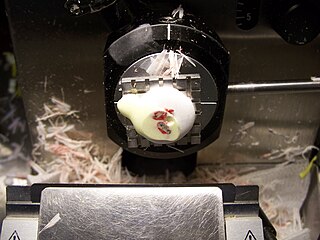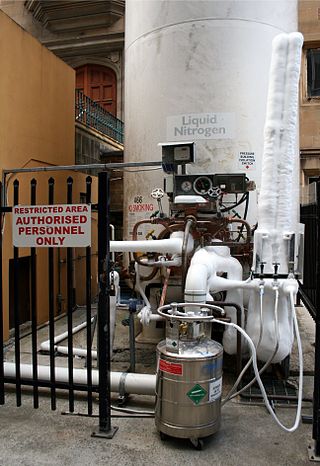
In physics, cryogenics is the production and behaviour of materials at very low temperatures.

A vacuum flask is an insulating storage vessel that slows the speed at which its contents change in temperature. It greatly lengthens the time over which its contents remain hotter or cooler than the flask's surroundings by trying to be as adiabatic as possible. Invented by Sir James Dewar in 1892, the vacuum flask consists of two flasks, placed one within the other and joined at the neck. The gap between the two flasks is partially evacuated of air, creating a near-vacuum which significantly reduces heat transfer by conduction or convection. When used to hold cold liquids, this also virtually eliminates condensation on the outside of the flask.
A cryopump or a "cryogenic pump" is a vacuum pump that traps gases and vapours by condensing them on a cold surface, but are only effective on some gases. The effectiveness depends on the freezing and boiling points of the gas relative to the cryopump's temperature. They are sometimes used to block particular contaminants, for example in front of a diffusion pump to trap backstreaming oil, or in front of a McLeod gauge to keep out water. In this function, they are called a cryotrap, waterpump or cold trap, even though the physical mechanism is the same as for a cryopump.

Liquid nitrogen—LN2—is nitrogen in a liquid state at low temperature. Liquid nitrogen has a boiling point of about −196 °C (−321 °F; 77 K). It is produced industrially by fractional distillation of liquid air. It is a colorless, mobile liquid whose viscosity is about one tenth that of acetone (i.e. roughly one thirtieth that of room temperature water). Liquid nitrogen is widely used as a coolant.

Liquid helium is a physical state of helium at very low temperatures at standard atmospheric pressures. Liquid helium may show superfluidity.

A 3He/4He dilution refrigerator is a cryogenic device that provides continuous cooling to temperatures as low as 2 mK, with no moving parts in the low-temperature region. The cooling power is provided by the heat of mixing of the helium-3 and helium-4 isotopes.

A superconducting magnet is an electromagnet made from coils of superconducting wire. They must be cooled to cryogenic temperatures during operation. In its superconducting state the wire has no electrical resistance and therefore can conduct much larger electric currents than ordinary wire, creating intense magnetic fields. Superconducting magnets can produce stronger magnetic fields than all but the strongest non-superconducting electromagnets, and large superconducting magnets can be cheaper to operate because no energy is dissipated as heat in the windings. They are used in MRI instruments in hospitals, and in scientific equipment such as NMR spectrometers, mass spectrometers, fusion reactors and particle accelerators. They are also used for levitation, guidance and propulsion in a magnetic levitation (maglev) railway system being constructed in Japan.
A refrigerator designed to reach cryogenic temperatures is often called a cryocooler. The term is most often used for smaller systems, typically table-top size, with input powers less than about 20 kW. Some can have input powers as low as 2–3 W. Large systems, such as those used for cooling the superconducting magnets in particle accelerators are more often called cryogenic refrigerators. Their input powers can be as high as 1 MW. In most cases cryocoolers use a cryogenic fluid as the working substance and employ moving parts to cycle the fluid around a thermodynamic cycle. The fluid is typically compressed at room temperature, precooled in a heat exchanger, then expanded at some low temperature. The returning low-pressure fluid passes through the heat exchanger to precool the high-pressure fluid before entering the compressor intake. The cycle is then repeated.

In vacuum applications, a cold trap is a device that condenses all vapors except the permanent gases into a liquid or solid. The most common objective is to prevent vapors being evacuated from an experiment from entering a vacuum pump where they would condense and contaminate it. Particularly large cold traps are necessary when removing large amounts of liquid as in freeze drying.
A microtome is a cutting tool used to produce extremely thin slices of material known as sections, with the process being termed microsectioning. Important in science, microtomes are used in microscopy for the preparation of samples for observation under transmitted light or electron radiation.

The frozen section procedure is a pathological laboratory procedure to perform rapid microscopic analysis of a specimen. It is used most often in oncological surgery. The technical name for this procedure is cryosection. The microtome device that cold cuts thin blocks of frozen tissue is called a cryotome.
The sorption pump is a vacuum pump that creates a vacuum by adsorbing molecules on a very porous material like molecular sieve which is cooled by a cryogen, typically liquid nitrogen. The ultimate pressure is about 10−2 mbar. With special techniques this can be lowered till 10−7 mbar. The main advantages are the absence of oil or other contaminants, low cost and vibration free operation because there are no moving parts. The main disadvantages are that it cannot operate continuously and cannot effectively pump hydrogen, helium and neon, all gases with lower condensation temperature than liquid nitrogen. The main application is as a roughing pump for a sputter-ion pump in ultra-high vacuum experiments, for example in surface physics.
A lambda point refrigerator is a device used to cool liquid helium, typically around a superconducting magnet or for low temperature measurements, from approximately 4.2 K to temperatures near the lambda point of helium, the temperature at which normal fluid helium transitions to the superfluid helium II. Cooling is achieved by pumping the liquid helium in the bath through a cooling coil via a needle valve and vacuum pump. The reduced pressure in the coil causes some of the helium to evaporate, creating a two-phase system within the cooling coil. The heat removed via evaporation lowers the temperature of the cooling coil closer to the lambda point. Since the cooling coil is immersed in the liquid helium bath, liquid surrounding the coil is also cooled. The colder, higher density liquid sinks away from the coil toward the bottom of the bath while the warmer, lower density liquid helium rises to the top. Liquid helium typically has poor thermal conductivity, so convective currents associated with a temperature gradient in the bath provide a constant flow of this colder liquid helium toward the bottom of the bath, allowing temperatures below 4.2 K to be realized in the helium bath, typically close to 2.2 K.

The pulse tube refrigerator (PTR) or pulse tube cryocooler is a developing technology that emerged largely in the early 1980s with a series of other innovations in the broader field of thermoacoustics. In contrast with other cryocoolers, this cryocooler can be made without moving parts in the low temperature part of the device, making the cooler suitable for a wide variety of applications.

Superconducting radio frequency (SRF) science and technology involves the application of electrical superconductors to radio frequency devices. The ultra-low electrical resistivity of a superconducting material allows an RF resonator to obtain an extremely high quality factor, Q. For example, it is commonplace for a 1.3 GHz niobium SRF resonant cavity at 1.8 kelvins to obtain a quality factor of Q=5×1010. Such a very high Q resonator stores energy with very low loss and narrow bandwidth. These properties can be exploited for a variety of applications, including the construction of high-performance particle accelerator structures.
The Holbrook Superconductor Project is the world's first production superconducting transmission power cable. The lines were commissioned in 2008. The suburban Long Island electrical substation is fed by a 600 meter long tunnel containing approximately 155,000 meters of high-temperature superconductor wire manufactured by American Superconductor, installed underground and chilled to superconducting temperature with liquid nitrogen.
Cryofixation is a technique for fixation or stabilisation of biological materials as the first step in specimen preparation for the electron microscopy and cryo-electron microscopy. Typical specimens for cryofixation include small samples of plant or animal tissue, cell suspensions of microorganisms or cultured cells, suspensions of viruses or virus capsids and samples of purified macromolecules, especially proteins.
A refrigerated transport Dewar is a refrigerated transport vessel with an insulated Dewar flask (vacuum) design to carry cryogenic liquid. To prevent pressure build-up they are equipped with safety relief valves and/or rupture discs. The liquid can be withdrawn as a gas by passing liquid through an internal vaporizer or as a liquid under its own vapour pressure.
Atomic Spectroscopy and Collisions Using Slow Antiprotons (ASACUSA), AD-3, is an experiment at the Antiproton Decelerator (AD) at CERN. The experiment was proposed in 1997, started collecting data in 2002 by using the antiprotons beams from the AD, and will continue in future under the AD and ELENA decelerator facility.

A cryogenic storage dewar is a specialised type of vacuum flask used for storing cryogens, whose boiling points are much lower than room temperature. It is named after inventor James Dewar, who developed it for his own work. They are commonly used in low-temperature physics and chemistry.











